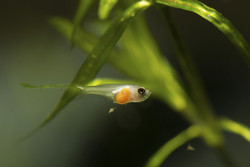Modelling suction feeding in fish larvae
Newly hatched fish larvae live off a limited supply of yolk and must encounter and capture food before it runs out. In addition, their small size means they experience water as a mainly viscous medium, as the flow around an organism depends on its size and swimming speed. This is characterised by the dimensionless Reynolds number. Smooth, laminar flow occurs at a low Reynolds number, whereas as a high Reynolds number denotes turbulent flow. The SFHABILF (Suction feeding hydrodynamics and biomechanics in larval fishes) project investigated the hydrodynamic basis of prey capture in fish larvae and its effect on feeding performance. The development of the fish larvae and their subsequent increase in speed and size cause a transition to a higher Reynolds number, which influences their feeding. A range of flow visualisations, experiments with live fish and models were therefore used to provide insights into suction feeding in fish larvae. Researchers constructed a computational fluid dynamics (CFD) model that modelled mouth expansion from the size of first feeding larvae to adult fish. The aim was to investigate whether and how feeding patterns change with larvae size and Reynolds numbers. Results showed that changes in flow patterns have a significant effect on prey capture performance. Changes in the Reynolds number, the suction-induced flow field around the mouth and feeding performance explained a shift in diet from passive prey to evasive prey as the larvae mature. A more elaborate CFD model was then used that included the gills and results for five larval sizes. In addition, visualisations of suction flows with live larvae were conducted. This work was supported by studies on the feeding rate of gilt head sea bream (Sparus aurata) larvae in the laboratory using high-speed videos. A data set of over 700 feeding events of larvae was used to understand failure in prey capture during growth. These experiments showed that larval size, rather than age, impeded sucking function. Moreover, small larvae may be less effective feeders, but larvae with a small Reynolds number swim slower, thereby reducing the encounter rate with prey. The results of the SFHABILF project will help provide a clearer understanding of how change in the marine environment following a global warming will affect larval survival and sustainability of fish stocks.



